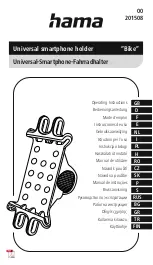
2
Coverage Area
The RH-250 has a maximum coverage range of 180 degrees and a coverage area of 600 square feet (56
square meters). The sensor must have a clear and unobstructed view of the coverage area. Objects blocking
the sensor’s lens may prevent detection thereby causing the light to turn OFF even though someone is in the
area.
NOTE:
Windows, glass doors, and other transparent barriers will obstruct the sensor’s view and prevent
detection.
INSTALLATION & WIRING
These instructions describe only the 3-way circuit applications.
For information about other applications,
consult technical support.
1.
Prepare the switch box
After the power is turned OFF at the circuit breaker box,
remove the existing wall plate and mounting screws. Pull
the old switch out from the wall box.
2.
Identify the type of circuit
You may connect the RH-250 to a single pole or multi-way
circuit. If you are unable to clearly identify some or all of the
wires mentioned in this manual, you should consult with a
qualified electrician.
In a 3-way circuit (see Fig. 2), two traveler wires connect
to both switches. Another wire provides power from the
circuit box to one of the switches. A wire connects from one
switch to the load. A ground wire may also be connected to
a ground terminal on the old switches. A neutral wire should
also be present in both wall boxes.
CAUTION
For your safety: Connecting a proper ground to the sensor provides protection against electrical shock in the event of certain
fault conditions. If a proper ground is not available, consult with a qualified electrician before continuing installation.
3.
Prepare the Wires
Tag the wires currently connected to the existing switch so that they can be identified later. Disconnect the wires.
Make sure the insulation is stripped off of the wires to expose their copper cores to the length indicated by the
“Strip Gauge,” in Fig. 3. (approx. 1/2 inch).
4.
Wire the sensor
Twist the existing wires together with the wire leads on the RH-250 sensor(s) as indicated in either step 4a or 4b. Cap wires securely using
wire nuts.
a.
Wiring two RH-250s in a 3-way configuration
• Connect the green or non-insulated (copper) GROUND
wire from the circuit to the green terminal on each RH-
250.
• Connect the NEUTRAL wire from the circuit and from
the lamp (LOAD) to the white wire on the
master
RH-
250.
•
The term “master” designates the RH-250 that
connects to the load.
• Connect the NEUTRAL wire from the circuit in the other
wiring box to the white wire on the auxiliary RH-250.
• Connect the power wire from the circuit box (HOT)
to the black wire on the auxiliary RH-250 and to the
TRAVELER 1 wire.
• Connect the TRAVELER 1 wire from the black wire of the auxiliary RH-250 to the black wire of the master RH-250.
• Connect the lamp power (LOAD) to the red wire on the master RH-250.
• Cap the red wire on the auxiliary RH-250.
• Connect the TRAVELER 2 wire coming from the yellow wire of another RH-250 to the yellow wire of the RH-250 that you are wiring.
P
P
Fig. 1: Sensor Coverage Area
Strip Gauge
1/2"
12.7mm
Fig. 3: Wire Stripping
NEUTRAL
GROUND
LOAD/Common
(power to lamp)
GROUND
HOT/Common
Lamp/load
TRAVELER
TRAVELER
(power from circuit box)
NEUTRAL
MASTER SWITCH
AUXILIARY SWITCH
Fig. 2: Typical 3-Way Switch Wiring
MASTER RH-250
AUXILIARY RH-250
qOT
TOP
INDO
OR U
SE O
NLY
L
L
Red – Load
(power to lamp
or fan)
White –
Neutral
Red – capped
Ground
Terminal
White –
Neutral
Yellow – Traveler 2
to AUX RH-250
Yellow – Traveler 2
to Master RH-250
Line (power
from circuit box)
Black – Traveler 1
power to
Master RH-250
Black – Traveler 1
power from
AUX RH-250
Ground
Terminal
Fig. 4: Step 4a. Sensor orientation, wire connections and wall box
assembly
WARNING
DISCONNECT POWER TO THE WALL SWITCH BOX BY
TURNING OFF THE CIRCUIT BREAKER OR REMOVING THE
FUSE FOR THE CIRCUIT BEFORE INSTALLING THE RH-250,
REPLACING LAMPS, OR DOING ANY ELECTRICAL WORK.






























